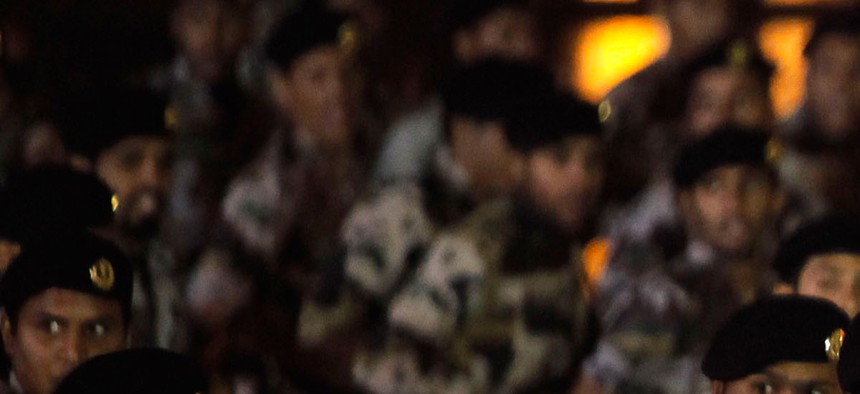
Saudi military soldiers march during a military parade marking the Hajj in October 2013 Amr Nabil/AP
Saudi Arabia Unveils Ballistic Missiles in Military Parade, But Why Now?
For the first time ever, Saudi Arabia showed off ballistic missiles it's had since the 1980s. To find out why, analysts point 1,200 miles northeast of Riyadh. By Rachel Oswald
Saudi Arabia on Tuesday for the first time displayed its medium-range ballistic missiles -- a move that analysts interpreted as primarily aimed at Iran.
A pair of Dongfeng-3 missiles were rolled out during a military parade in Riyadh. The Saudi government bought the missiles from China in 1987 but had refrained for decades from publicly showing them off, according to an analysis by the Washington Institute for Near East Policy.
The weapons traditionally are kept deployed at a base to the south of the Saudi capital, where they are positioned for possible launches against Iran, said Washington Institute fellow Simon Henderson.
In recent years, Saudi Arabia reportedly acquired more sophisticated Chinese Dongfeng-21 missiles, but there were no reported sightings of those missiles during Tuesday's parade.
"The missile display signals Saudi Arabia's determination to counter Tehran's growing strength, as well as its readiness to act independently of the United States," Henderson said.
Saudi Arabia is worried that ongoing talks between world powers and Iran will fail to produce a deal that permanently ends Tehran's potential to construct a nuclear weapon. A prominent Saudi prince recently urged other Arab Gulf nations to develop advanced atomic capabilities in order to create a "balance of forces" against Iran.
Pakistani army chief Gen. Raheel Sharif was in attendance at Tuesday's parade. His presence will likely "reawaken speculation" that the Saudi government could attempt to acquire Pakistani atomic weapons in order to counter Iran, Henderson said.
In a blog post for Arms Control Wonk, Aaron Stein, an associate fellow at the Royal United Services Institute, posited that Saudi Arabia was trying to send a message to the Obama administration over "its current discomfort with the way the U.S. has handled Syria, the Arab Spring and the Iranian nuclear issue.
NEXT STORY: Why Assad’s Re-Election Campaign Matters




